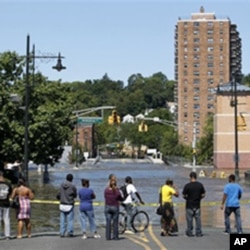Path of Hurricane Irene in August 2011. At peak intensity, Irene reached Category 3 hurricane status with sustained winds of 125 mph. (Courtesy NOAA)
With climate change, powerful storms could make landfall far more frequently, causing powerful, devastating storm surges every three to 20 years, researchers from MIT and Princeton University have found.
Their study proposes a way to more accurately assess the risks posed by more frequent and intense hurricanes and sea rise, especially in coastal communities most threatened by the earth’s changing climate.
New York City was the focus of the study. Scientists coupled computer climate models with hurricane models and generated some 45,000 virtual storms within a 200-kilometer radius of New York.
Princeton University atmospheric scientist and study co-author Michael Oppenheimer says, while there was some variability among the models, the common feature was a greater frequency of intense storms. That confirmed findings from previous studies.
“What we found was that indeed, a surge level, that is a level of penetration of flood water inland during a storm, that would previously have been reached perhaps every 100 years, is now going to be reached maybe once a decade, which is quite a big change in the risk and something that coastal managers really have to start planning for.”
About half the world’s population lives within 200 kilometers of a coastline, and that number is rising as more people move to cities in low-lying areas, according to the Population Reference Bureau.
Oppenheimer believes urban planners must be able to evaluate the risks climate change will pose to life and property.
“What is the probability that something of a certain level of impact will happen?" he says. "And how do we prevent that? Do we raise the sea walls around the city? Do we have better evacuation plans? Do we ultimately plan for some sort of storm surge barrier?”
According to Oppenheimer, as the world changes, so must our response to it.
“We need to anticipate that world," he says. "We don’t want to just sit there and take the punch. We want to be ready for it when it comes.”
While the study analysis is based on New York, Oppenheimer says the technique the team used could be applied anywhere.
“We’re looking at this as one modest step in a direction that humanity is going to have to move over time, in getting smarter about dealing with the world that one way or another is going to get warmer, with more threats, while the world also hopefully gets its act together to cut emissions to start reducing the risk eventually.”









